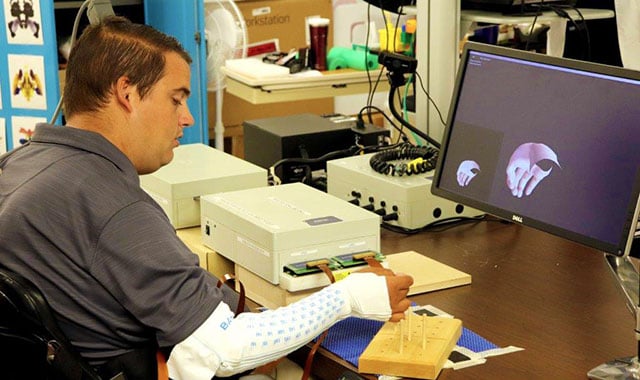One Step Closer to NeuroLife Home Use

Machine learning and artificial intelligence (AI) have the potential to revolutionize the medical field. They can help improve diagnostics, treatments and access to care. Here at Battelle, we have leveraged improvements in AI to bring medical advances into the homes of those who need it.
Using the Battelle NeuroLife® technology, we’ve shown that a man suffering from quadriplegia can regain control of his paralyzed hand in a laboratory setting.
Our neural bypass system has three parts.
- A Blackrock Utah Array that is implanted on the surface of the brain and detects neural activity.
- A custom set of Battelle-designed software and algorithms that decode that activity.
- A sleeve we developed that goes on the forearm and translates those impulses into movements through electrical stimulation.
Even with the remarkable progress we’ve seen with NeruoLife, we still have a long way to go. One step in that direction is making the system more portable and robust for use outside of the laboratory. Improving the algorithms is a key component to taking this system home.
This week, in a paper published in Nature Medicine, with our collaborators at The Ohio State University Wexner Medical Center and a trailblazing study participant, Ian Burkhart, we have shown we are one step closer to bringing the system home.
Bloomberg coverage of NeuroLife™ - View complete NeuroLife™ YouTube Playlist
We combined years of collected data from Ian with advances in AI to improve the algorithms that process the neural data and decode Ian’s intended movement. We were able to reduce the overall set-up time, reduce the time and amount of data necessary to recalibrate the system, decrease the response time, increase the accuracy, and make it generalizable to new movements.
In this research, we focused on the components necessary to make NeuroLife work outside of the laboratory and meet the needs of users. By changing our framework of daily retraining to a system that incorporates data from previous sessions and more sophisticated models we are one step closer to our goal.
Previously, each time Ian used NeuroLife, he spent about a half hour calibrating the decoding algorithm, which is about as much time as he spent using it to move his right hand. He is prompted to think about a movement and the algorithm uses that data to create a map of his neural activity for different movements. It took many repetitions before he and the machine were on the same page. Using our new algorithms, this is no longer the case.
“You need the system to just be able to work at home,” Ian said. “You don’t want to be fine tuning and adjusting it constantly when you’re trying to go about your daily life. This paper shows that we’re at the point where you can have it set up, do some training with the clinicians and go home and keep using it. You don’t want to be in the middle of doing something and stop and readjust the system.”
Ian is exactly right. In the future, we envision the NeuroLife system at home. When Ian wants to brush his teeth, he’ll have previously trained the system for this activity, and can call up the decoder to brush his teeth without having to recalibrate it each time. It must be user friendly and fast. And we’re determined to get there.
Dave Friedenberg, Mike Schwemmer, and Nick Skomrock are Battelle statisticians on the NeuroLife Machine Learning team and are co-authors of the Nature Medicine paper.
Sign Up for Battelle Updates
Follow along with the latest news, announcements and updates from our Battelle community of solvers.